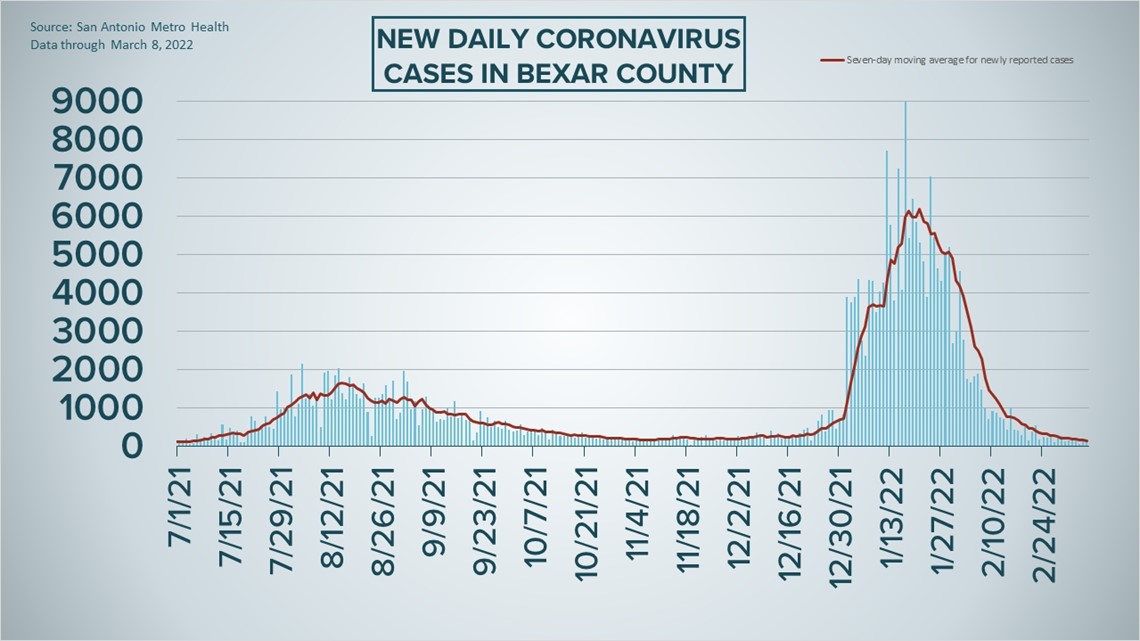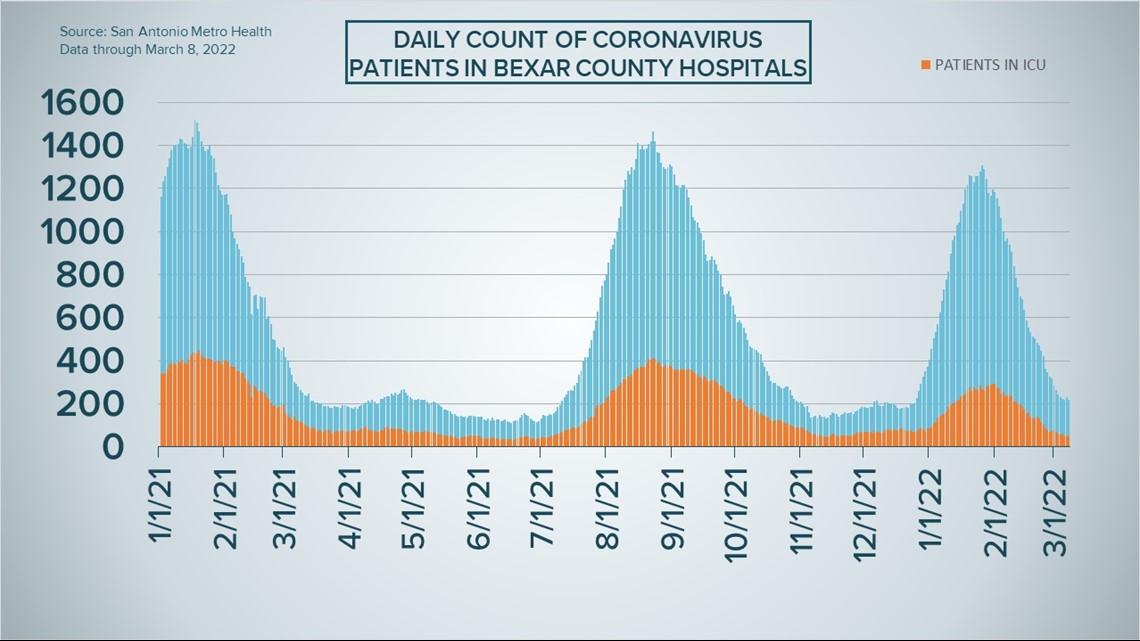SAN ANTONIO — For the first time since early November – several weeks before the highly contagious omicron variant starting spreading in earnest and Bexar County began contending with its biggest surge of COVID-19 infections of the pandemic – health authorities on Tuesday downgraded the region's coronavirus risk level to "low."
It's the lowest threshold on Metro Health's metric for virus spread, and the latest indication that the community's current COVID-19 outlook is as bright as any point over the last two years.
Metro Health officials reported 123 new diagnoses for the San Antonio area on Tuesday, which brings the seven-day case average down to 133; the last time the average was that low was last summer ahead of the delta variant's arrival. March has averaged 148 new infections a day so far, compared to 935 in February and nearly 4,800 in the first month of the year.
Meanwhile, local COVID-19 hospitalizations decreased slightly on Tuesday after going up on Monday. There were 220 patients receiving treatment in local facilities for their symptoms, which is down by 22% over the last week and by 77% over the last month.
Of those 220 patients, 48 are in intensive care and 36 are using ventilators.
Health officials also reported four more virus-related deaths on Tuesday, bringing Bexar County's death toll during the pandemic to 5,287. More than 525,000 area residents have been infected with the coronavirus.
How Bexar County is trending




Vaccine Progress in Bexar County
The following numbers are provided by San Antonio Metro Health. A full breakdown can be found here.
- 1.75 million eligible Bexar County residents have received at least one dose of the coronavirus vaccine as of Thursday, March 3.
- 1.427 million eligible Bexar County residents are fully vaccinated as of Thursday, March 3.
The CDC states that "when a high percentage of the community is immune to a disease (through vaccination and/or prior illness)," that community will have reached herd immunity, "making the spread of this disease from person to person unlikely."
The City of San Antonio breaks down the vaccination rates by zip code on Metro Health's Vaccination Statistics page.
Coronavirus in Texas
The total number of coronavirus cases in the state since the pandemic began grew by 4,989 on Tuesday, according to the Texas Department of State Health Services. That total includes 1,575 new confirmed cases and 3,414 new probable cases. More details can be found on this page.
Tuesday's figures bring the total number of Texans diagnosed with COVID-19 to more than 6.578 million.
An additional 95 Texans have died from virus complications, meanwhile, raising the statewide death toll to 84,513.
Coronavirus symptoms
The symptoms of coronavirus can be similar to the flu or a bad cold. Symptoms include fever or chills, cough, shortness of breath or difficulty breathing, fatigue, muscle or body aches, headache, new loss of taste or smell sore throat, congestion or runny nose, nausea or vomiting, and diarrhea, according to the Centers for Disease Control.
Most healthy people will have mild symptoms. A study of more than 72,000 patients by the Centers for Disease Control in China showed 80 percent of the cases there were mild.
But infections can cause pneumonia, severe acute respiratory syndrome, kidney failure, and even death, according to the World Health Organization. Older people with underlying health conditions are most at risk.
Experts determined there was consistent evidence these conditions increase a person's risk, regardless of age:
- Chronic kidney disease
- COPD (chronic obstructive pulmonary disease)
- Obesity (BMI of 30 or higher)
- Immunocompromised state (weakened immune system) from solid organ transplant
- Serious heart conditions, such as heart failure, coronary artery disease, or cardiomyopathies
- Sickle cell disease
- Type 2 diabetes
- The CDC believes symptoms may appear anywhere from two to 14 days after being exposed.
Human coronaviruses are usually spread...
- Between people who are in close contact with one another (within about 6 feet).
- Through respiratory droplets produced when an infected person coughs, sneezes or talks. These droplets can land in the mouths or noses of people who are nearby or possibly be inhaled into the lungs.
- Some recent studies have suggested that COVID-19 may be spread by people who are not showing symptoms.
Help stop the spread of coronavirus
- Stay home when you are sick.
- Eat and sleep separately from your family members
- Use different utensils and dishes
- Cover your cough or sneeze with your arm, not your hand.
- If you use a tissue, throw it in the trash.
Find a Testing Location
City officials recommend getting a COVID-19 test if you experience fever or chills, cough, shortness of breath or difficulty breathing, fatigue, muscle or body aches, headache, new loss of taste or smell, sore throat, congestion or runny nose, nausea or vomiting, or diarrhea.
Here's a Testing Sites Locator to help you find the testing location closest to you in San Antonio.
Latest Coronavirus Headlines
- Yes, some at-home COVID tests contain a toxic chemical, but they’re safe when used correctly
- Coronavirus Tracker: CDC relaxes mask recommendations for Bexar County as COVID-19 outlook improves
- FDA adds another COVID-19 test to 'do not use' list
- Global COVID death toll hits 6 million in 2 years of pandemic
- Yes, some at-home COVID tests contain a toxic chemical, but they’re safe when used correctly
- Odessa health leader reflects on 2-year anniversary of first presumptive case of COVID-19 in Texas
- Two years into pandemic, NFL suspends all COVID-19 protocols

